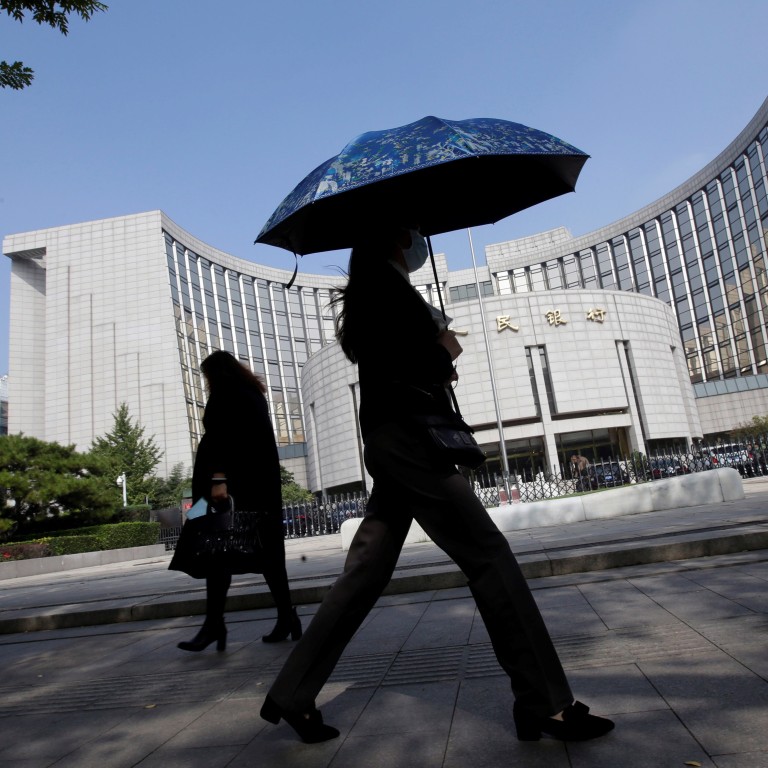
China’s proposed digital currency will help banks bridge gap on mobile payment, curb dominance of Alipay, WeChat
- With Alipay and WeChat Pay accounting for over 90 per cent of the mobile payment market and drawing away deposits, analysts say PBOC’s proposed digital currency will help banks stem the leak
- Banks’ participation in the central bank’s digital currency will help them better compete with third party payment network operators
The PBOC set up the project in 2014 to look into launching its own digital currency to cut the costs circulating cash and boost policymakers’ control of money supply. Although the project has been closely guarded, various media reports suggest that the central bank’s researchers have been working intensively on the cryptocurrency’s systems for the past year.
Mu Changchun, deputy director of the PBOC’s payment and settlement department, gave more details about the nearly ready digital currency last week at an industry conference in Heilongjiang, saying the PBOC would rely on Chinese commercial banks to be the conversion agency, helping to convert cash in circulation into the PBOC-backed digital currency, and vice versa.
It also signals PBOC’s urgency in launching its own digital currency after Facebook announced details about its Libra cryptocurrency project in mid-June. Global central banks, including the PBOC, have reiterated that Libra must be put under central bank oversight to prevent potential foreign exchange risks and protect the authority of monetary policy.
China close to launching cryptocurrency, says central bank, amid pressure from Facebook’s Libra
Mu said that the digital currency “may not necessarily be dependent on blockchain” and will be used only to support small value retail transactions.
Analysts said this could also rein in the dominance of the country’s two third-party payment operators like Ant Financial’s Alipay and Tencent Holdings’ WeChat Pay, which together account for 90 per cent of mobile payment transactions in China, as retail depositors would switch some of their payment transactions to the PBOC-issued digital cash. Ant Financial is an affiliate of Alibaba Group Holding, which owns the South China Morning Post.
Cindy Wang, an analyst at DBS Group Research, said by involving banks as the fiat-to-digital currency conversion agent, the PBOC wants to make sure that when the digital currencies are converted back into renminbi, the money can flow back into banks’ deposit accounts.
“Currently, banks are under pressure to retain their deposit base because, with the money market funds distributed by third-party payment providers like Alipay or Tencent, some of the idle money held in mobile payment accounts are leaked out of the banking system into the hands of fund managers,” said Wang.
Alipay operates a money-market fund distribution platform which hosts the world’s largest money market fund called Yu’e Bao, with total assets of 1.03 trillion yuan (US$146 billion) as of June.
By designating banks as the agent to convert between the PBOC digital currency and fiat money, then banks could use their own internet banking services to retain cash held by individuals and merchants and ultimately, turn them into banks’ deposits.
“With banks’ loan-to-deposit ratio rising, if banks continue to lose their deposit base it will be difficult for them to keep up with their lending, so through the digital currency the PBOC hopes to divert some of the deposits back to the banking system,” said Wang.
According to the China Banking and Insurance Regulatory Commission, Chinese banks’ loan-to-deposit ratio in the second quarter stood at 72.85 per cent, up from 69.12 per cent a year ago.
Personal deposits held at banks as of July stood at 78.9 trillion yuan, while deposits held by nonbank payment operators totalled 1.29 trillion yuan, according to PBOC data.
Hui Kai-lung, a professor at the Hong Kong University of Science and Technology’s department of information systems, said by designating Chinese banks as the conversion agency, the PBOC is enabling them to regain the channel through which they could capture and analyse customers’ transaction data.
“Commercial banks have been disadvantaged in competing for mobile payment businesses because the big data related with the end users’ payment and online behaviour has been captured by Alipay and WeChat Pay. But with their new role under the PBOC’s digital currency initiative, I expect banks to form their own platform and network on big data,” said Hui.
In recent years, Chinese banks have been increasing their focus on retail banking through digitalisation, as they try to catch up with big fintech groups for a share of the consumer lending businesses, which are increasingly approved and disbursed online.
While most analysts expect it might take several years before Chinese banks could take meaningful market share in mobile payment, Wang expects some banks which are early movers in retail banking would benefit more from the PBOC digital currency project than others.
“Those that are more aggressive in mobile banking, such as China Merchants Bank and Ping An Bank, could be keen to work with the PBOC and support this digital currency project,” said Wang.
A spokesperson from Ant Financial declined to comment, while spokespersons from Tencent were not available for comment.


